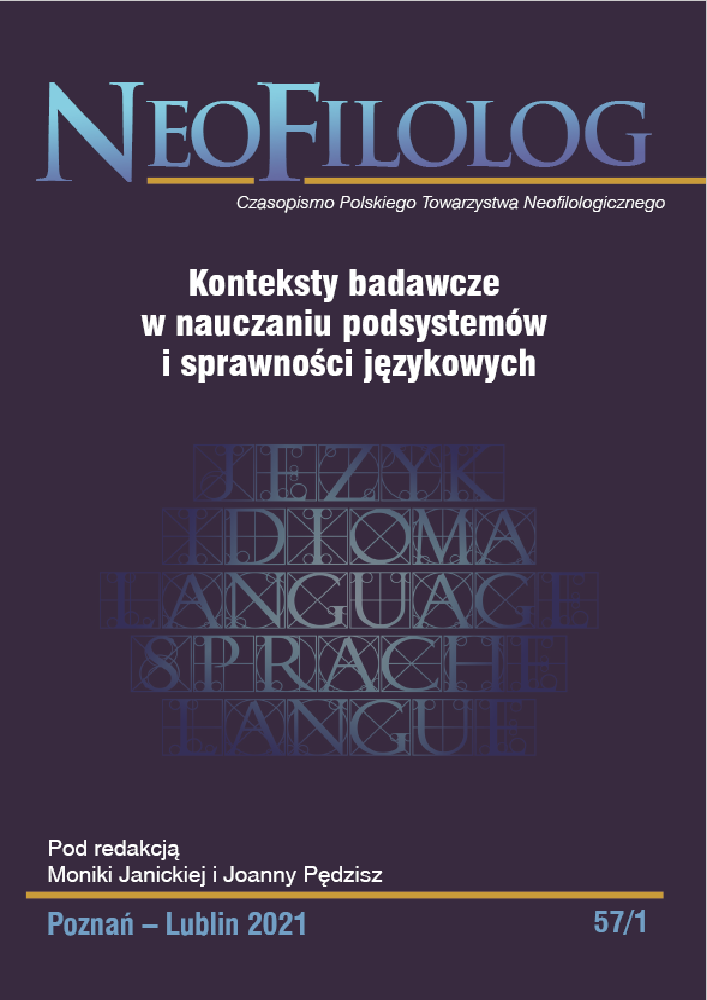Abstrakt
Nie tylko specjalne potrzeby edukacyjne, lecz także cechy rozwojowe silnie determinują specyfikę nauczania podsystemu leksykalnego jezyka obcego w edukacji przedszkolnej. Celem tego artykułu jest prezentacja wyników badania, przeprowadzonego pośród grupy dzieci pięcioletnich, dotkniętych spektrum autyzmu oraz zespołem Aspergera. Dążeniem tego konkretnego kontekstu pedagogicznego edukacji przedszkolnej jest przeanalizowanie trudności i ich możliwych modyfikacji w metodyczne możlwości. Po pierwsze, wykorzystując perspektywnę neurobiologiczną zaprezentowana zostanie specyfika nauczania podsystemu leksykalnego wśród dzieci. Następnie omówione zostaną szczególne potrzeby i umiejętności dzieci ze spektrum autyzmu oraz zespołem Aspergera. Praktyczna część artykułu powstała na bazie badania, przeprowadzonego w roku szkolnym 2018/2019 w Warszawie. Eksperyment pozwolił na zdiagnozowanie czy zastosowanie teorii inteligencji wielorakich, zadań multisensorycznych oraz zabawy dydaktycznej w kontekście przedszkolnej edukacji specjalnej wpływa na proces nauczania-uczenia się języka obcego.
Bibliografia
Alexiou T., Milton J., Roghani S. (2019), Assessing the Vocabulary Knowledge of Preschool Language Learners. Integrating Assessment into Early Language Learning and Teaching, United Kingdom: Multilingual Matters, s. 154-164.
Cichmińska M. (2015), Bawię się więc jestem. „Języki Obce w Szkole”, nr 1, s. 13-17.
Dufrêne G., Chambres E., Chambres P. (2009), Le syndrome d’Asperger: atouts et particularités. „Bulletin scientifique de l’arapi”, nr 23, s. 59-65.
Gardner H. (1983), Frames of Mind: The Theory of Multiple Intelligences. New York City: Basic Books.
Hüther G., Hauser U. (2014), Wszystkie dzieci są zdolne. Jak marnujemy wrodzone talenty. Słupsk: Wydawnictwo Dobra Literatura.
Kic-Drgas J. (2015), Czym skorupka za młodu nasiąknie…, czyli kilka uwag o kształceniu interkulturowym najmłodszych. „Języki Obce w Szkole”, nr 1, s. 36-42.
Komorowska H. (2005), Metodyka nauczania języków obcych. Warszawa: Fraszka Edukacyjna.
Konderak T. (2017), Podejście wielozmysłowe w nauczaniu języków obcych dzieci. „Edukacja elementarna w teorii i praktyce”, nr 4(46), s. 97-99.
Kondrat D. (2011), Wykorzystanie inteligencji wielorakich w nauczaniu języka angielskiego. „Języki Obce w Szkole”, nr 4, s. 2-10.
Kotarba-Kańczugowska M. (2015), Przedszkolak uczy się języka obcego. Kręta droga, wielka frajda. „Języki Obce w Szkole”, nr 1, s. 43-49.
Medina J. (2012), Jak wychować szczęśliwe dziecko. Kraków: Wydawnictwo Literackie.
Milton J., Alexiou T. (2009), Vocabulary size and the Common European Framework of Reference for Languages, (w:) Richards B., Daller H. M., Malvern D.D., Meara P., Milton J., Treffers-Daller J. (red.), Vocabulary Studies in First and Second Language Acquisition. Basingstoke: Palgrave Macmillan, s. 194-211.
Ministère de l’éducation nationale (2009), Scolariser les élèves autistes ou présentant des troubles envahissants du développement. Paris : CNDP.
Mottron L. (2004), L’autisme: une autre intelligence. Sprimont: Mardaga.
Mottron L. (2010), Que fait-on de l’intelligence autiste? „Enfance”, nr 1, s. 45-57.
Piotrkowska-Skrzypek M. (2015), Kompetencje nauczyciela języka obcego w przedszkolu. „Języki Obce w Szkole”, nr 1, s. 23-31.
Pisula E. (2010), Autyzm. Przyczyny, symptomy, terapia. Gdańsk: Wydawnictwo „Harmonia”.
Sowa-Bacia K. (2019), Kryteria wyboru materiałów dydaktycznych w nauczaniu języka obcego na etapie przedszkolnym. „Języki Obce w Szkole”, nr 5, s. 75-79.
Tiefenthal C. (2008), Fast mapping im natürlichen L2-Erwerb. Trier: WVT.
Vanthier H. (2009), L’enseignement aux enfants en classe de langue. Paris : CLE International.
Wierzchosławska A. (2018), Nauczanie multisensoryczne w przedszkolu wraz z przykładami ćwiczeń. „Języki Obce w Szkole”, nr 1, s. 48-50.
Wolski A. (2013), Ograniczone, powtarzające się̨ i stereotypowe wzorce zachowań, zainteresowań i aktywności u małych dzieci ze spektrum autyzmu. „Konteksty pedagogiczne”, nr 1, s. 45-63.
Wójcik-Gugulska M. (2017), Zajęcia z dużą grupą przedszkolaków mogą być świetną zabawą! „Języki Obce w Szkole”, nr 2, s. 104-107.
Licencja
Prawa autorskie (c) 2021 Monika Szymańska

Utwór dostępny jest na licencji Creative Commons Uznanie autorstwa – Bez utworów zależnych 4.0 Międzynarodowe.
Przedstawiany utwór (artykuł) upubliczniany jest na podstawie umowy z autorem i na licencji Creative Commons Attribution-NoDerivatives 4.0 International (CC BY-ND 4.0).
Użytkownicy mają obowiązek podania wraz z rozpowszechnionym utworem, informacji o autorstwie, tytule, źródle (odnośniki do oryginalnego utworu, DOI) oraz samej licencji;
- bez tworzenia utworów zależnych,
- utwór musi być zachowany w oryginalnej postaci.
Uniwersytet im. Adama Mickiewicza w Poznaniu zachowuje prawo do czasopisma jako całości (układ, forma graficzna, tytuł, projekt okładki, logo itp.).

